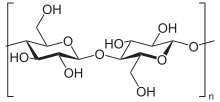
Back Beta-glukan BS Beta-glukan Czech Beta-Glucane German Beta glucano Spanish Beta-glukano Basque Beetaglukaani Finnish Bêta-Glucane French Béta-glükán Hungarian Β-glucani Italian Β-グルカン Japanese
This article is missing information about biosynthesis. (August 2019) |

Beta-glucans, β-glucans comprise a group of β-D-glucose polysaccharides (glucans) naturally occurring in the cell walls of cereals, bacteria, and fungi, with significantly differing physicochemical properties dependent on source. Typically, β-glucans form a linear backbone with 1–3 β-glycosidic bonds but vary with respect to molecular mass, solubility, viscosity, branching structure, and gelation properties, causing diverse physiological effects in animals.
At dietary intake levels of at least 3 g per day, oat fiber β-glucan decreases blood levels of LDL cholesterol and so may reduce the risk of cardiovascular diseases.[1] β-glucans are natural gums and are used as texturing agents in various nutraceutical and cosmetic products, and as soluble fiber supplements.
- ^ Ho, H. V; Sievenpiper, J. L; Zurbau, A; Blanco Mejia, S; Jovanovski, E; Au-Yeung, F; Jenkins, A. L; Vuksan, V (2016). "The effect of oat β-glucan on LDL-cholesterol, non-HDL-cholesterol and apoB for CVD risk reduction: A systematic review and meta-analysis of randomised-controlled trials". British Journal of Nutrition. 116 (8): 1369–1382. doi:10.1017/S000711451600341X. PMID 27724985.